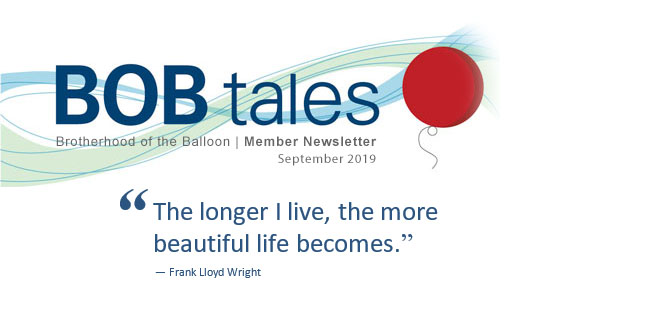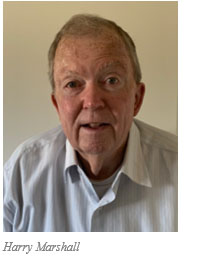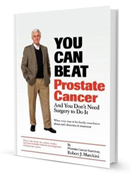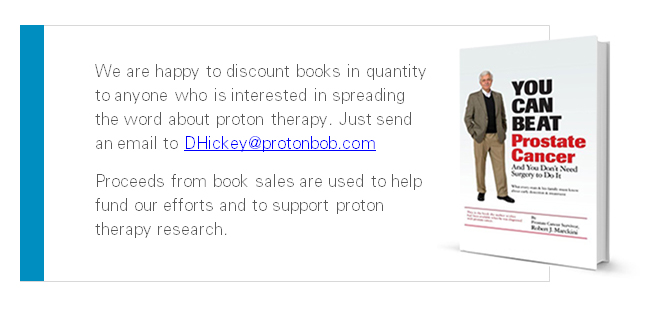
.jpg) Dear Members (a note from Deb Hickey):
Dear Members (a note from Deb Hickey):
I bought this T-shirt for my father, Bob Marckini, for his birthday this past April. It reads, “Vintage … Since 1943 … All Original Parts … Aged to Perfection.” When I found it on Amazon, I thought it was humorous. Bonus: It’s my dad’s favorite color (FYI: All his shirts are blue—sweaters, too).
It wasn’t until he put it on that I focused on the “all original parts” line and thought: Well, that’s fitting.
September is National Prostate Cancer Awareness Month. It’s the perfect time to talk to your family and friends about the most common cancer affecting American men. More than 170,000 new cases will be diagnosed, and more than 30,000 men will die from prostate cancer by the end of the year. And as you may know, about 5 to 10 percent of all prostate cancers are hereditary, so talk to your sons, your brothers, your cousins, and your grandchildren. Educate them about early detection and encourage them to research treatment options.
In this photo, my dad is healthy, happy, and whole at his beautiful home by the ocean because of proton therapy. Thank God he found his way to Loma Linda. And thank God private insurers were covering the treatment back in 2000.
Today some private insurance companies refuse to cover proton therapy, claiming it’s not “medically necessary.” Some still use the “experimental” or “investigational” excuses. While proton therapy is more expensive, tens of thousands of men have been successfully treated with protons with excellent results. But insurers still fall back on their claim that proton therapy has never been proven, through randomized clinical trials, to be superior to the lower cost alternative. That angers me to my core. And that’s why we continue to fight back. The first story in this issue focuses on several initiatives that aim to reverse the trend of denying coverage for proton therapy.
Also this month, we share the results of the most recent National Association for Proton Therapy member survey of 27 operating centers on disease sites treated along with any reportable trends. We also report on a new study comparing the hypofractionated, shorter treatment proton therapy protocol to the standard, full-course treatment. We also discuss using PSA density as a diagnostic tool and the latest on the benefits of an MRI-guided biopsy. Our Health section this month begins with a summary of what I believe to be one of the most important TED Talks I’ve watched. It’s called “The Brain-Changing Effects of Exercise.” I made my husband sit down and watch the video with me; and we’re in the process of changing our exercise (or lack thereof) habits.
And finally, in last month’s opening memo, I mentioned that July was the 5th anniversary of my husband’s pancreatic cancer remission. I received dozens of messages from members who told me they appreciated my openness and offered their congratulations and continued prayers. I appreciate each one. I’m happy to report that Mark just had his 5-year checkup with his oncologist who told him there’s no need for further CT scans. God continues to bless us. And the celebration continues!
As always, we hope you enjoy this issue of BOB Tales. We welcome and appreciate your feedback. Just send an email to [email protected].
Deb Hickey
To print the BOB Tales newsletter or view the newsletter with a larger font size, click here for the PDF file.
In this Issue:
- Private Insurance Coverage for Proton Therapy—The Battle Continues
- National Association for Proton Therapy (NAPT) Member Survey
- Shorter Proton Treatment Protocol Just as Effective as Full Course of Treatment
- PSA Density as a Diagnostic Tool
- A Better Way to Detect Prostate Cancer
- The Brain-Changing Effects of Exercise

Private Insurance Coverage for Proton Therapy—The Battle Continues
As we’ve reported in the past, Medicare typically covers proton therapy for prostate cancer and other diseases for older citizens in the U.S. But younger people who are not on Medicare must rely on private insurance to pay for their medical treatments. Over the years, most private insurers have stopped covering proton therapy claiming it hasn’t been proven to be superior to conventional radiation. Thus, they claim the higher cost isn’t justified.
Private insurers may be ignoring that significantly less radiation is deposited on healthy tissue than with conventional X-ray radiation, reducing the likelihood of side effects and secondary cancers later in life. They also may overlook empirical data and patient surveys reporting excellent quality of life following proton therapy.
Consequently, many patients are faced with fighting battles through the appeals process, often losing and having to pay out-of-pocket for proton, or having to choose an alternative treatment option.
But there’s cause for hope. The battle to reinstate coverage for proton therapy by private insurers is being fought on three fronts: clinical trials, legislative changes, and the legal process.
Clinical Trials Under Way
There are two clinical trials under way comparing proton therapy to IMRT for treating prostate cancer—PARTIQoL and COMPPARE. The PARTIQoL study is the first randomized trial of its kind to evaluate proton therapy vs. IMRT. Patients with low- or intermediate-risk prostate cancer have been invited to participate. The COMPPARE trial, which is still in the early stage, is a large, comprehensive effort that is enrolling 3,000 patients (1,500 proton and 1,500 IMRT). The study will involve 45 treatment sites─both proton and IMRT─and will run approximately five years. Bob Marckini and Deb Hickey are involved in the COMPPARE study team. We’re very impressed with the team, its leadership, the project scope, and the plans for carrying it forward. We expect both studies to show differences in results relative to disease-free survival and quality of life after treatment.
Legislative Changes
Last month we reported on the great success Oregon State Sen. (and BOB member) Bill Hansell had in sponsoring a bill that was unanimously approved by the Senate, the House, and then signed by the governor. This new law requires private insurers in the state to cover proton therapy to the same degree they cover other radiation therapies. This was a major undertaking by Sen. Hansell requiring considerable skills in working with the insurance lobby as well as convincing colleagues on both sides of the aisle to support this legislation. This was a huge win for the proton movement and for the people of Oregon.
The Legal Process
We announced in our July issue the formation of the Proton Therapy Law Coalition initiated by California-based law firm, Kantor & Kantor. This firm, along with two others and some patient advocacy groups—including the BOB—are tackling the denial process head on by bringing nationwide pressure on insurance companies to cover proton therapy. To date, they’ve had some success in turning around individual cases through the appeals process, including a case we reported on last month.
These law firms have also been aggressive in filing class-action lawsuits on behalf of individuals who’ve been denied coverage. Last month, Kantor and Kantor filed their fourth nationwide ERISA class-action lawsuit in the past four months challenging insurers’ denials of proton therapy for cancer treatment. The latest is against BCBS of North Carolina. In addition, three other class actions were filed across the country including:
- Weissman v. UnitedHealthcare, et. al., Case No. 1:19-cv-10580-ADB (D. Mass. March 26, 2019). Attorneys: Callahan & Blaine, Kantor & Kantor, LLP and Mala M. Rafik
- Cole v. UnitedHealthcare, et. al., Case No. 1:19-cv-21258-FAM (S.D. Fla., Amended, April 3, 2019) Attorneys: Colson Hicks Eidson
- Day v. Humana Insurance Company, Case No. 1:19-cv-03141 (N.D. Ill., May 9, 2019) Attorneys: DeBofsky Sherman Casciari Reynolds PC
The insurers listed are among the most prominent in the industry. Considerable attention and pressure are being brought to bear on their practices of denying coverage for proton therapy.
We’re hopeful that through these efforts─clinical trials, legislative changes, and the legal process─we can reverse the trend of denying coverage for proton therapy and allow patients access to this important cancer-fighting and quality of life preserving technology.
Update: Proton vs. IMRT PARTIQoL Clinical Trial
.jpg) We mentioned the PARTIQoL randomized controlled clinical trial in the above article on private insurance coverage. Last month we reached out to Jason Efstathiou, MD, Director, Genitourinary Service, Department of Radiation Oncology, Mass. General Hospital. Dr. Efstathiou is lead researcher on the PARTIQoL project. We asked him for an update on this important trial and he provided us with the following:
We mentioned the PARTIQoL randomized controlled clinical trial in the above article on private insurance coverage. Last month we reached out to Jason Efstathiou, MD, Director, Genitourinary Service, Department of Radiation Oncology, Mass. General Hospital. Dr. Efstathiou is lead researcher on the PARTIQoL project. We asked him for an update on this important trial and he provided us with the following:
Both intensity modulated radiation therapy (IMRT) and proton beam therapy (PBT) are currently used and considered equally effective in treating and curing localized prostate cancer. However, both treatments have the potential to cause side effects due to radiation, including bowel, urinary and erectile issues. Though both forms of radiation therapy have been used successfully, there has never been a head-to-head study directly comparing these two therapies in a rigorous prospective comparative fashion.
Our Phase III randomized controlled clinical trial (RCT), Prostate Advanced Radiation Technologies Investigating Quality of Life (PARTIQoL), directly compares proton therapy to IMRT to determine which therapy best minimizes the side effects of treatment and leads to superior patient-reported quality of life (in addition to other endpoints).
The study has been open at 36 centers nationally, including 15 proton centers. In April 2019, we welcomed the newest institution to the study, Miami Cancer Institute. PARTIQoL is steadily marching towards its target enrollment. As of July 11, 2019, the study has accrued 355 out of a planned 400 subjects to the RCT, and separately 209 subjects to the companion registry study. The registry is designated for patients who choose not to be randomized and instead elect to pursue either proton therapy or IMRT or for those where insurance coverage directs choice. Currently, the RCT is on track to reach the target accrual goal by early 2020 and results are expected by 2022.
National Association for Proton Therapy (NAPT) Member Survey
We’re often asked by members, “What conditions can be treated with proton therapy?” Or, “I have a friend with esophageal cancer. Can this be treated with protons?”
There are 27 operating proton center members of NAPT along with an additional five members with proton centers under construction or development.
Recently NAPT conducted a survey of the 27 operating centers on disease sites treated along with any reportable trends.
Cancers/Conditions treated at member proton centers include: central nervous system (CNS), brain tumors, pituitary melanoma, bone tumors including base of skull and axial skeleton, interocular neoplasms, lung, soft tissue sarcoma, multiple pediatric tumors (including CNS and lymphoma), gastrointestinal tract tumors including pancreas and esophagus, hepatobiliary, colon, rectal, female pelvic organs, prostate, breast and other tumor sites.
Prostate cancer represents about 27 percent of cancers treated. And while the total number of prostates treated is increasing, the prostate percentage of total treatments has dropped from 43 percent five years ago. This is due to a combination of factors including the growth of other conditions treated with protons and declining coverage approval by private insurers.
Sadly, almost 50 percent of patients (not just prostate cancer patients) were initially denied coverage by their insurers. Many of these denials were reversed after the appeals process and more were approved after independent review.
Almost all proton centers are offering some form of hypofractionation (higher dose, fewer treatments) – mostly in the 20 to 28 treatment range vs. the 40 to 44 standard treatment protocol. A small number of proton centers are offering the five-treatment, Stereotactic Body Radiation Therapy (SBRT) protocol for certain qualifying patients.
Shorter Proton Treatment Protocol Just as Effective as Full Course of Treatment
Back in February 2018, we wrote about a study published in European Urology Focus that concluded the following for photon (X-ray) radiation therapy: “There is evidence for clinicians to consider hypo-fractionated radiation therapy (HRT) as compared with conventionally fractionated high-dose external beam radiation therapy (CRT) as a preferred radiation treatment in men with intermediate-risk prostate cancer and at low risk of other complications.” Researchers stated that a shorter course of radiation with higher doses over fewer days may be the preferred approach in appropriately selected patients with localized prostate cancer because it reduces treatment time and cost to the patient while providing convenience and access to treatment.
A more recent study that examined data on non-metastatic prostate cancer patients treated with 28 doses of proton therapy versus the standard 44 had similar results. Researchers found the rates of cancer control at four years were the same in both groups. In comparing the proton therapy study with the conventional photon radiation study from 2018, researchers noted key differences, however. Photon radiation typically uses multiple X-ray beams to attack a tumor while also depositing radiation to normal, healthy surrounding tissue and continues to radiate healthy tissue as it exits the target. Alternatively, proton therapy directs positively charged protons at the tumor and stops, depositing the bulk of the radiation dose. This allows for minimal residual radiation to surrounding healthy tissue thereby reducing side effects and the risk for secondary cancers. Due to these differences, researchers point out the need to better understand patient results for the hypofractionated approach in protons, specifically.
PSA Density as a Diagnostic Tool
PSA typically comes from two places: Healthy prostate tissue and prostate cancer cells. Men with large prostates have more prostate tissue and, in general produce more PSA, regardless of whether cancer is present. Some men with normal, or even low PSA levels, have been found to have prostate cancer; And some men with high PSA levels have been found to be cancer free.
Calculating PSA density can help doctors determine whether your PSA results are normal or cancerous. PSA density is determined by dividing your PSA by your prostate size in milliliters (mL) or cubic centimeters (cc). A man with a PSA of 2.6 mg/mL, with a prostate volume of 35mL would have a PSA density of 2.6/35 = 0.074. A rule of thumb is that “standard” PSA density is 0.15. Lower numbers are considered safer and higher numbers should be looked at more closely.
A man with a PSA of 8.7 and a prostate volume of 30 mL would have a PSA density
of 0.29. And a man with PSA of 11 and prostate volume of 80 mL would have a PSA density of 0.14. In these examples, the individual with the lower PSA has the more worrisome PSA density.
Some doctors believe that PSA density is a reasonably good tool to use for men with high PSAs, but not a very good predictor of cancer activity for men with PSAs below 4 ng/mL.
A Better Way to Detect Prostate Cancer
We’ve written about this before, but it bears repeating: Every year, one million men in the U.S. undergo biopsies to determine whether they have prostate cancer. Unfortunately, most of them are still undergoing old-fashioned, “blind” biopsies. Conventional biopsies are called “blind” for a reason—doctors can’t see what they’re aiming for and as a result, cancers are being missed.
For years, researchers have been trying to develop better, more refined methods for detecting prostate cancer, and that effort has paid off. Studies show that using advanced MRI-guided biopsy with traditional ultrasound picks up more cancers—in fact, the cancer detection rate is about 30 percent greater than a blind biopsy.
Read the latest article on the benefits of MRI-guided biopsy.

Connecting With Members Treated Long Ago
We like to periodically check in with members treated long ago and attempt to track down those we’ve lost touch with. Considering we have about 10,000 members, and more than 3,500 were treated more than 10 years ago, the process is daunting. But we’re slowly making progress and receiving some truly fantastic updates. Below is an excerpt from an email we received from a member treated 14 years ago. Harry is on one of our reference lists, volunteering to speak with prospective proton patients who’ve had a recurrence after surgery and are considering proton therapy for salvage treatment.
 Thank you for checking on me. I’m doing fine. It’s been 14 years since I received proton salvage treatment after my prostatectomy failed, and my PSA remains undetectable. I feel very fortunate to this day that I was a part of the incredible experience of proton beam therapy. I’m still in awe of the groundbreaking technology that was created at Loma Linda. I enjoy telling people about the benefits of proton therapy, so please keep me on the reference list for those who’ve had proton therapy as salvage treatment so that I can steer prospective patients to the lifesaving and wondrous proton beam therapy.
Thank you for checking on me. I’m doing fine. It’s been 14 years since I received proton salvage treatment after my prostatectomy failed, and my PSA remains undetectable. I feel very fortunate to this day that I was a part of the incredible experience of proton beam therapy. I’m still in awe of the groundbreaking technology that was created at Loma Linda. I enjoy telling people about the benefits of proton therapy, so please keep me on the reference list for those who’ve had proton therapy as salvage treatment so that I can steer prospective patients to the lifesaving and wondrous proton beam therapy.
─Harry Marshall, 76, Treated at LLUCC in 2005
Connecting with More Recently Treated Members
We’ve recently received several inquiries from prospective patients who wish to speak with more recently treated members, so it prompted us to update our reference lists. When Deb sent an initial email request for volunteers (there will be more), she was inundated with offers, compliments, and well-wishes. Through communications like these, we’re also able to really get to know our members, which we enjoy. Below is an excerpt from a message sent by a member Deb helped in 2016 when he was trying to decide on treatment and having problems with his insurance provider.
It’s fantastic to hear from you once again. Thanks for reaching out! I realize how busy and demanding your position must be, and I want you to know that BOB members are grateful and blessed that you are our advocate and representative for proton beam therapy. Keep up the fight!
Life is great! Loma Linda and proton therapy have given me control of my life again … I surf close to 70 days a year up here in New Hampshire, and I’ve begun my lifelong dream of hiking all 48 4,000-foot mountains in my state, too!
─Gary Murtagh, 62, Treated at LLUCC in 2017

We have been producing BOB Tales newsletters monthly for more than 18 years. During this time there have been important articles that many new members have not seen, and some older members may have forgotten. So, we decided to periodically re-run some articles from past newsletters. The following two articles were written by Bob Marckini 14 years ago in April 2005, when we had 1,945 members in our group.
“The Answer to Cancer”
While in Bonita Springs, I had the opportunity to attend a lecture by Dr. Carolyn Runowicz, Director of the University of Connecticut Cancer Center and Vice President of the American Cancer Society. Dr. Runowicz has co-authored a book, The Answer to Cancer, with Dr. Sheldon Cherry.
The authors’ theory is that cancer is the most preventable and the most curable of all life-threatening diseases. And the book focuses on preventing cancer using the latest developments in pharmaceutical technology, lifestyle changes, and other cancer prevention strategies.
One common theme in the book—and you’ve read it here before—is the fact that eating fruits and vegetables reduces cancer risk. Also, that being overweight increases risks for many cancers. Dr. Runowicz points out that while there are certain factors beyond our control, such as age, ethnicity, and family history, there are factors that are ours to change, such as diet and exercise. She also stressed the importance of a healthy immune system in preventing about 100 cancers.
Regarding prostate cancer, the authors had the following recommendations:
- Eat a minimum of five servings of fruits and vegetables a day and shoot for nine.
- Limit your consumption of red meat. And if you do eat meat, choose lean cuts and smaller portions.
- Limit high-fat dairy products.
- Increase physical activity.
- Maintain a healthy weight.
- Don’t smoke.
- Get annual DREs and PSA tests by age 50 or by age 45 if African American or if you have family history of prostate cancer.
Nothing new here for the well-informed members of the BOB.
Want to Keep Your Heart Healthy? Brush Your Teeth!
Sound crazy? It did to me too, but I’m married to a dental hygienist and have heard about some of these things before. An article in The Press-Enterprise quoted Dr. Nikola Angelov, a periodontist/researcher at Loma Linda University School of Dentistry, on the subject of “focal infection,” which refers to oral bacteria causing a variety of systemic conditions; and may even be linked to myocardial infarction (heart attacks).
Our saliva is a breeding ground for bacteria, which forms a glue that binds to the tooth, according to Dr. Craig Ririe, director of the department of periodontics at LLU School of Dentistry. “First it goes on the tooth and then it crawls down between the gum and the tooth.” The bacteria under the gum crevice act as an incubator. The bacteria grow and eventually get into your bloodstream. This bacterium may affect pregnant women and put them at risk for premature birth. The article reports that gum infections can be prevented. Brushing and flossing are important, but they are not enough. Regular dental check-ups and hygienist cleanings are essential. According to Dr. Ririe, pregnant women should have their teeth cleaned every three months. In addition to brushing our teeth, we’re advised to brush our tongue as well.

Contributor Quotes
Every month, we receive a list of members who’ve made contributions to the Robert Marckini Chair for Proton Therapy Research or Loma Linda University Health’s Vision 2020 campaign, though we don’t know the exact amounts given. We make every attempt to get in touch with everyone on these lists by phone to thank them for their generosity. We love the conversations we have, and we often save some of their comments. Following are a few examples.
I enjoy your newsletter more than the Sunday paper. ─BOB Member, Stanley, ID
Proton therapy gave me a lot of borrowed time, which is good and bad—I get to spend more time with my family, but my knees are killing me. ─BOB Member, Huntington Beach, CA
You provide a very good service to your members by checking in on them. I suspect you’re on the phone all the time. How do you get the newsletter written? ─BOB Member Spouse, Modesto, CA
I can’t begin to imagine how you get the newsletter out every month. It must be like writing a book forever. ─BOB Member, Apopka, FL
Give to Proton Therapy Research
- Donate online.
- Write a check to LLUCC Proton (Put “Marckini Chair” on the memo line) and mail it to LLUH, Office of Philanthropy, P.O. Box 2000, Loma Linda, CA 92354.
- Call Regina Joseph at 909-558-5010.
Give to Vision 2020
- Donate online.
- Write a check to LLUH Vision 2020 and mail it to LLUH, Office of Philanthropy, P.O. Box 2000, Loma Linda, CA 92354.
- Call 909-651-2020.

The Brain-Changing Effects of Exercise
What if there were something you could do right now that would have an immediate, positive benefit for your brain? And what if that could last a life-time, protecting your brain from conditions like depression, Alzheimer’s disease, and dementia? According to neuroscientist Wendy Suzuki, it’s exercise. In a TED Talk, Wendy discusses the science of how physical activity boosts your mood and memory—and protects your brain against neurodegenerative diseases. Important highlights from her talk are below.
- Our brain is the most complex structure known to mankind.
- The prefrontal cortex is critical for decision-making, focus, attention, and personality expression.
- The brain is divided into distinctive lobes. The temporal lobe is behind your ears and extends to both sides of the brain. The temporal lobe is involved in vision, memory, sensory input, language, emotion, and comprehension.
- Deep in the temporal lobe is a key structure critical for your ability to form and retain long-term memory for facts and events—the hippocampus.
- Exercise is the most transformative thing you can do for your brain for the following reasons:
- It has an immediate effect on the brain. A single workout will immediately increase levels of neurotransmitters that will improve your mood.
- A single workout can improve your ability to shift and focus attention. This improvement will last for at least two hours.
- A single workout will improve your reaction time.
- Though brain function improves directly after a workout, you have to change your exercise regime to get long-lasting effects.
- Exercise changes the brain’s anatomy, physiology, and function.
- Exercise produces new brain cells in the hippocampus that increase its volume and improve your long-term memory.
- The most transformative thing that exercise can do for your brain is to protect it from disease. Think of your brain like a muscle; The more you exercise, the stronger it gets. Why is this important? The prefrontal cortex and hippocampus are the two areas most susceptible to neurodegenerative disease and normal cognitive decline in aging.
- An increase in exercise over a lifetime will not cure dementia or Alzheimer’s disease, but it can create a stronger hippocampus so it takes longer for these diseases to have an effect.
- You don’t have to become a triathlete to get these effects. The rule of thumb is to exercise about 3-4 times per week for a minimum of 30 minutes a session. You should also do aerobic exercise to get your heart rate up.
Watch this excellent TED Talk video.
Can You Catch a Cold from Your Pet?
Theoretically, yes, but it’s unlikely, according to Parade Magazine (Marilyn vos Savant). Feline, canine and human upper respiratory illnesses are virtually specific to their species. Cats and dogs get these illnesses less often partly because fewer exist. Humans are susceptible to more than 200 cold viruses. Also, our pets aren’t exposed to other animals as much as humans are exposed to other humans. A mutation or evolving disease may indeed jump from animals to humans, but this is rare—and frightening: Remember “swine flu” and “bird flu?”
Fried Food Affects Mortality
According to a new study conducted by the College of Public Health at The University of Iowa, people who regularly eat fried chicken have a 12 percent higher risk of death due to cardiovascular issues. The study also found that individuals who ate fried food at least once per week had an 8 percent higher chance of death than those who didn’t.


A Family Thank You
The following message came from a member, treated in 2015, who just wanted to share an experience. We love getting these.
I wanted to share an experience I recently had. My daughter-in-law called and asked if I would talk to a co-worker who was diagnosed with prostate cancer. She had told him about proton therapy, Loma Linda, and my experience of treatment. I spoke with him and answered his questions. I also told him about Bob Marckini’s book and sent him a copy. He read it twice. Then he saw his urologist, who was apparently misinformed about proton therapy. He attempted to explain the benefits of proton therapy and informed his doctor that he’d made his treatment decision regardless of his doctor’s advice. He also said something I agree with wholeheartedly: “Bob’ s book is a must-read for every man who has or may be diagnosed with prostate cancer.”
I want to thank you for everything you’ve done and continue to do to help past and present prostate cancer patients.
─Dale Wood, 78, Treated at LLUCC in 2015
We were pleasantly surprised when we received another message from Dale’s daughter the following day:
My name is Connie Wood. I’m Dale’s daughter. I wanted to share with you that I’ve been helping my father spread the word about proton therapy by sharing Bob’s book. My cousin called and was asking a lot of questions about my dad’s treatment. She told me her friend’s father was recently diagnosed with prostate cancer. I answered her questions to the best of my ability after what I learned from going through this experience with my dad. I then told her about Bob’s book and how informative it was and that was how my dad made his decision to have proton treatment. I said I’d mail her a copy to give to her friend. My cousin let me know that her friend and her husband are both reading it and highlighting things they want to share with her father. Thanks to Bob’s book, men can make an informed decision regarding their treatment.
Thanks for letting me share this with you. I also want to thank you for all you do.
─Connie Wood
Recent Review
We read and appreciate every Amazon review. Here is a review posted on July 19.
 Excellent Resource and Support: This book is one of my most valuable resources; it provides the best pathway forward when facing prostate cancer. It’s written in a personal and understandable way. I referred to it before getting proton therapy and then after treatment for guidance on diet, supplements, and other things. The book is more than information—it’s like having a friend on the journey with you.
Excellent Resource and Support: This book is one of my most valuable resources; it provides the best pathway forward when facing prostate cancer. It’s written in a personal and understandable way. I referred to it before getting proton therapy and then after treatment for guidance on diet, supplements, and other things. The book is more than information—it’s like having a friend on the journey with you.
Buy Bob's book online, in bulk, or in Spanish.
Online: Paperback: $19.00--•--Kindle: $7.99--•--NOOK Book: $9.99--•--Apple iBook: $9.99
In Bulk: Conctact us for a discount price list. Proceeds from book sales support proton therapy research through the Robert J. Marckini Endowed Chair at LLUCC.
In Spanish: Buy the print version or in eBook format.


Did You Know …
- Supermarket apples can be a year old. They’re usually picked between August and November, covered in wax, hot-air dried, and sent into cold storage. After six to 12 months, they finally land on your grocery store shelves.
- It’s impossible to hum while holding your nose.
- Lobsters taste with their feet. The bristles inside a lobster’s pincers are their equivalent to human taste buds.
- The Empire State Building has its own zip code.
- A blue whale’s tongue can weigh as much as an elephant.
- Strawberries aren’t berries. And neither are raspberries and blackberries according to botanists. True berries stem from one single-ovary flower and have two or more seeds.
- British military tanks are equipped to make tea. There’s a boiling vessel inside so crew can make tea anytime, including during battle. How frightfully English.
The Hidden Cost of Traffic Tickets
According to car insurance search engine, Zebra, you could be paying a lot more for your car insurance if ticketed for certain offenses. For example:
- Failure to wear a seat belt typically adds 4 percent to your annual premium
- Not-at-fault accident adds 6.7 percent
- Texting while driving, 19.7 percent
- Failing to stop at a red light, 22.7 percent
- Speeding, 23.2 percent
- Improper passing, 23.4 percent
- At-fault accident 42 percent
- DUI, 73.9 percent
- Hit and run, 82.2 percent
Gluten-free May Not Be
According to Columbia University’s Mailman School of Public Health, restaurant food labeled as gluten-free may not be. Pizza and pasta labeled gluten-free were most likely to contain some gluten. It was present in 53 percent of pizza samples and 51 percent of pasta that was tested. The FDA says foods may be labeled gluten-free if they contain less than 20 parts per million of gluten. The restaurants tested and the amounts of gluten found in the above foods was not disclosed.

Last Month’s Brain Teaser
What is the only English word with three successive double letters?
Answer: Bookkeeper. A tricky alternative answer could be “Woollen,” where W is a “double u.”
Winner: BOB member John Leeson of Winter Springs, FL is the August BOB Tales brain teaser winner. John, 75, is a retired mathematics/statistics/computer science professor. He was diagnosed with high-risk prostate cancer in November 2017. Shortly thereafter, he read Bob Marckini’s book and chose proton therapy at the University of Florida Health Proton Therapy Institute in Jacksonville. He finished his treatment in March 2018 and his PSA has been undetectable for the past 15 months.
John and his wife Teresita enjoy spending time with their twin granddaughters. They also like to bowl and travel as often as they can. “We’re looking forward to many cancer-free years ahead,” said John.
Congratulations, John! Your signed copy of Bob’s book is in the mail.
New Brain Teaser
If you were to spell out numbers, how far would you have to go until you would find the letter “A?”
Send your answer to [email protected] for a chance to win a signed copy of Bob Marckini’s book, You Can Beat Prostate Cancer.
Groaners (Source)
- The meaning of opaque is unclear.
- I wasn’t going to get a brain transplant, but then I changed my mind.
- Have you ever tried to eat a clock? It’s very time consuming.
- A man tried to assault me with milk, cream and butter. How dairy!
- I’m reading a book about anti-gravity. I can’t put it down.
- So what if I don’t know the meaning of the word “apocalypse?” It’s not the end of the world.
- Police were called to the daycare center. A 3-year-old was resisting a rest.
- The other day I held the door open for a clown. I thought it was a nice jester.
- Need an ark to save two of every animal? I Noah guy.
- I used to have a fear of hurdles, but I got over it.
- Did you know they won’t be making yardsticks any longer?
- I used to be allergic to soap, but I’m clean now.
- What is a thesaurus’ favorite dessert? Synonym buns.
- A relief map shows where the restrooms are.
Tap on the Shoulder
 A taxi passenger tapped the driver on the shoulder to ask him a question. The driver screamed, lost control of the car, nearly hit a bus, went up on the footpath, and stopped centimeters from a shop window.
A taxi passenger tapped the driver on the shoulder to ask him a question. The driver screamed, lost control of the car, nearly hit a bus, went up on the footpath, and stopped centimeters from a shop window.
For a second everything went quiet in the cab. Then the driver said, “Please don’t ever do that again. You scared the daylights out of me!”
The passenger apologized and said, “I didn’t realize that a little tap would scare you so much.”
The driver replied, “Sorry, it’s not your fault. Today is my first day as a cab driver—I’ve been driving a hearse for 25 years.”
Quote of the Month:
Interesting Health Statistic: “A recent study found that women who carry a little extra weight live longer than the men who mention it.”

Struggling Will Make You Stronger Source
Once upon a time, a man found a butterfly that was starting to hatch from its cocoon. He sat down and watched the butterfly for hours as it struggled to force itself through a tiny hole. Then, it suddenly stopped making progress and looked like it was stuck.
Therefore, the man decided to help the butterfly. He took a small pair of scissors and cut off the remaining bit of the cocoon. The butterfly then emerged easily, although it had a swollen body and small, shriveled wings.
The man thought nothing of it, and he sat there waiting for the wings to enlarge to support the butterfly. However, that never happened. The butterfly spent the rest of its life unable to fly, crawling around with small wings and a swollen body.
Despite the man’s kind heart, he didn’t understand that the restricting cocoon and the struggle needed by the butterfly to get itself through the small hole were God’s way of forcing fluid from the body of the butterfly into its wings to prepare itself for flying once it was free.
Moral: Our life struggles help develop our strengths. Without struggles, we never grow and get stronger, so it’s important for us to tackle challenges on our own, and not rely on help from others all the time.
Low PSAs to all,
Bob Marckini and Deb Hickey
To print the BOB Tales newsletter or view the newsletter with a larger font size, click here for the PDF file.
NO MEDICAL ADVICE: Material appearing here represents opinions offered by non-medically-trained laypersons. Comments shown here should NEVER be interpreted as specific medical advice and must be used only as background information when consulting with a qualified medical professional.
